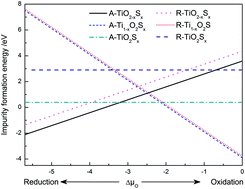Analysis of sulfur modification mechanism for anatase and rutile TiO2 by different doping modes based on GGA + U calculations
Abstract
In order to confirm the doping effects of sulfur on the photocatalytic performance of TiO2, the crystal structure, electronic structure, and optical properties of S-doped anatase and rutile TiO2, in which sulfur impurity occupies the lattice oxygen or titanium sites and the interstitial sites, were calculated by density functional theory within GGA + U method. If sulfur impurity incorporates into anatase and rutile lattice by the same doping mode, it exhibits similar doping effects (including lattice distortion, variation of band gap, localized defect states, and type and position of impurity energy levels). However, there are some subtle different doping effects between different crystal structures or different doping modes. According to the calculated results and basic relationship between electronic structure and photocatalytic performance, it is determined that sulfur interstitial doping in anatase TiO2 processes optimal modification effects due to its shallow impurity energy levels, located at the top of the valence and the bottom of the conduction band, which could not only improve the absorption of visible light, but also suppress the recombination of photo-generated electron–hole pairs.


 Please wait while we load your content...
Please wait while we load your content...